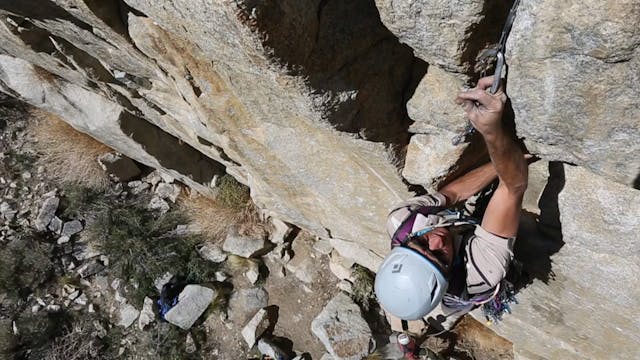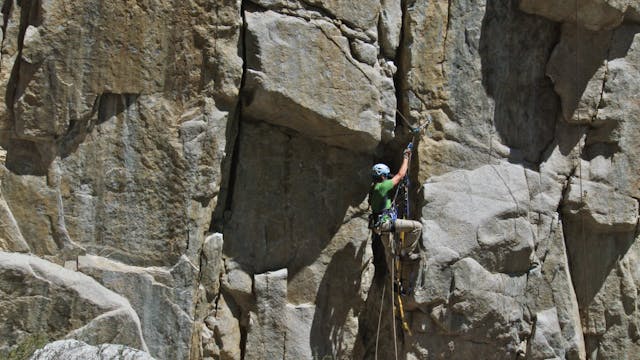Aid Climbing: 21. Transitions
Aid Climbing & Big Walls
•
2m 50s
In this video we discuss transitioning between leading, cleaning, and leading again while aid climbing.
Organization is key to ensuring a smooth transition. All aspects from how you rack, to where you clip your jumars when leading, to how you clean the gear, if you use 2 aiders or 3 aiders, and if you tie back-up knots or use a GriGri… All these things take time!
Time is not something you can waste when you’ve only packed three days of water and the top is still two days away!
For Leading:
Have a system and routine that works for you.
Develop habits that work for you, such as clipping gear in the same place every time so you know where to find it. Clip the tag line, your jumars, and rarely-used items such as hooks and rivet hangers to the same spot on your harness every time.
As mentioned in our partner communication video, telling your belayer when you are close to the next anchor gives them time to prepare for cleaning. They can start to put away food or jackets, and prepare the “pigs” (haul bags) for hauling.
At the Anchor:
A neatly organized anchor is paramount to increasing overall efficiency.
When you reach the anchor, think about how your partner will approach it and where they (or you, depending on if you’re swinging leads or leading in blocks) will be heading, in order to start the next pitch.
Do your best to visualize the greater picture, so you don’t have haul lines running over fixed lead lines. Think about how the haul bags will arrive, and where they will go next.
Regarding Cleaning:
As mentioned in the cleaning basics video, it pays to take extra time re-organizing gear as you clean it so that when you reach the anchor (if you’re swinging leads), you can simply gather the extra gear you need, refill your water, grab the tag line and/or haul line, and head out on lead.
If you pay attention and focus on keeping things organized, you will sail smoothly through these vertical seas and enjoy your time much more.
We hope you found this video helpful. Feel free to comment below with questions or thoughts!
Please remember, climbing is inherently dangerous. Climb at your own risk.
Up Next in Aid Climbing & Big Walls
-
Aid Climbing: 22. Portaledges
In this video we discuss portaledges. A portaledge is a hanging tent system designed for rock climbers who spend multiple days and nights on a big wall climb. They have a frame that tensions fabric for a flat sleeping surface. They can be finicky to set up, so be sure to practice before you hop o...
-
Aid Climbing: 23. Route Considerations
How do you start out your big wall or aid climbing career? In this video, we discuss how to ease into the sport of Aid Climbing.
When starting out aid climbing, we recommend you take it slow, unless you have a great mentor who is willing to do everything needed if things get dicey and you get...
-
Aid Climbing: 24. The Mental Game of ...
In this video we discuss the mental aspects of climbing big walls. A common phrase you may hear about aid climbing big walls is “wig balling”. This phrase is used to convey the mental breakdown a climber may suffer during multiple days in “the Twilight Zone.”
Our CTT Athlete and AMGA certifie...


